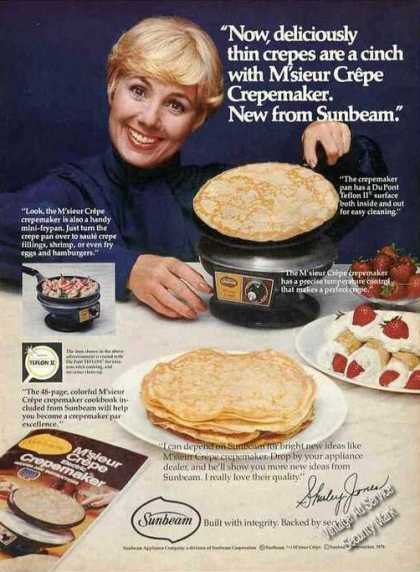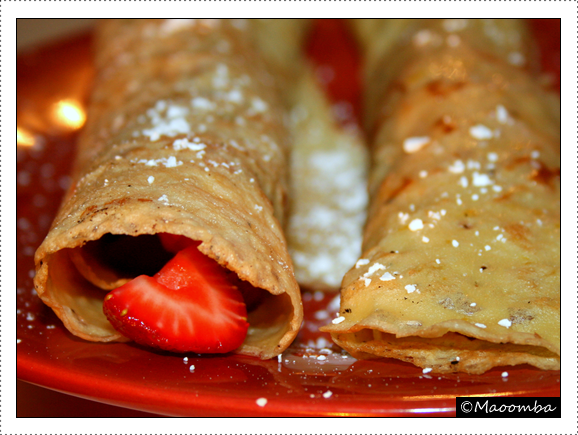According to Lou Seibert Pappas, an authority on the subject, dessert crepes were originally made from wheat flour, and savory crepes, interestingly, were made with buckwheat – a gluten-free seed that is milled into flour. Crepes were also cooked on good old cast iron pans, instead of the fancy, electric crepe cooking appliances available today.
On a side note, I happened to see two 70s-era crepe makers at a local thrift store last week and resisted my temptation to buy one.

But I digress. Dessert crepes can easily be made with cornstarch. Starch isn’t the healthiest thing in the world, but I can guarantee you that it results in fluffier, lighter crepes than wheat flour ever will.
The recipe I use was originally shared by Tom Vanderbeek, Executive Chef of Eiffel Tower Catering. I have modified it make it nondairy. The recipe is easy and delicious, but does take a little patience – unfortunately, to get the best texture, you need to wait half an hour before cooking the crepes. For people who plan to make the batter before dinner, I’m sure this isn’t an issue. Usually, though, I am inspired to make them when I crave them, making the wait too long.
A few notes on making amazing crepes
Pans – I use a cast iron griddle, but have also had success with stainless steel and non-stick pans. It is up to you. You can even use a crepe maker if you are lucky enough to have one.
Pre-heating – Make sure your pan is hot before adding butter (nondairy alternative, or dairy if you eat it) to it. To do this, turn your stove to between medium/medium-high heat and allow the pan to heat up for a couple of minutes before you add the butter. Add only a little bit of butter, but coat the pan completely. The butter should almost smoke, but not quite – add your batter immediately.
NOTE: Pre-heating your pan does a couple of things: allows the heat to spread evenly throughout the cooking surface, keeps your fats (butter, oil, etc.) from degrading – basically you are ready to cook the moment the fats is added to the pan, and it helps keep moisture in the foods you cook. Most importantly, it changes the molecular structure of the cooking surface in a way that prevents food from sticking to it. Heat matters whether you are cooking pancakes, sauteing vegetables, or pan-frying meat.
Nondairy ingredients – I use Earth Balance vegan buttery spread in place of butter and soy milk instead of regular milk. You can use other nondairy milks, but soy seems to turn out crepes with the best texture and flavor.
Speed – Pouring and spreading the batter quickly will give you the most even results. There are two ways to spread the batter – lifting and rotating the pan in a circular motion immediately upon pouring, or using a thin metal spatula like you would use to frost a cake to spread the batter while the pan remains on the stove.
Waiting – As I mentioned before, by letting the crepe batter rest for half an hour, you wind up with a smoother texture. This is mostly because it gives the corn starch a chance to absorb the liquid completely, making the batter thicker.
Storing the batter – You can refrigerate unused batter for a day or two. If it separates, simply whisk it before using it again.
Storing the crepes – Cooked crepes can be stored for up to 3 days. Simply stack them, wrap them in plastic wrap, and refrigerate. Let them warm to room temperature before eating.
Filling the crepes – Crepes make a delicious dessert when filled with fresh-sliced strawberries, raspberries, or peaches, and lightly dusted with powdered sugar. They are also good with melted GF/DF chocolate or homemade nutella (like from this recipe in the LA Times), or black cherry preserves (especially if you use the lemon zest in the recipe).
Cornstarch crepes with fresh fruit

Notes
This recipe makes approximately 16 crepes. At 2 minutes a piece, it can take up to half an hour to cook them all. My preference is to do just that and then store the rest for later, rather than heating the pan up again.
Ingredients
- 3 eggs
- 1 cup soy milk (or other nondairy milk)
- 1 teaspoon vanilla
- 3 Tbsp melted nondairy butter alternative (plus extra for pan)
- ¾ cup corn starch
- Pinch of salt
- 1 Tbsp sugar
- Optional: 1 tsp lemon zest
- Optional: 1 Tbsp poppy seeds
Instructions
- Whisk eggs in a large mixing bowl. Add milk, vanilla, and melted butter. Whisk in cornstarch, salt, and sugar. If using, stir in lemon zest and poppy seeds (I highly recommend that you do). Let batter rest for half an hour.
- -4 minutes before cooking, heat wide pan – at least 6 to 7 inches – to medium high heat. When hot, add a little bit of butter and spread across the pan evenly. Remove pan from heat to prevent smoking.
- Stir the batter and pour ⅛ of a cup into the pan. Quickly spread the batter – with a tilt and rotate motion or by using a thin spatula – to cover the bottom of the pan evenly. Return the pan to the heat.
- Cook the crepe for one minute, loosening the edges with a spatula as it cooks. When the top of the crepe should looks almost dry, flip it over. Cook the other side for a minute and transfer the crepe to a plate.
- Repeat the process until you’ve made as many crepes as you want. Add a little butter to the pan periodically to keep the crepes from sticking.
